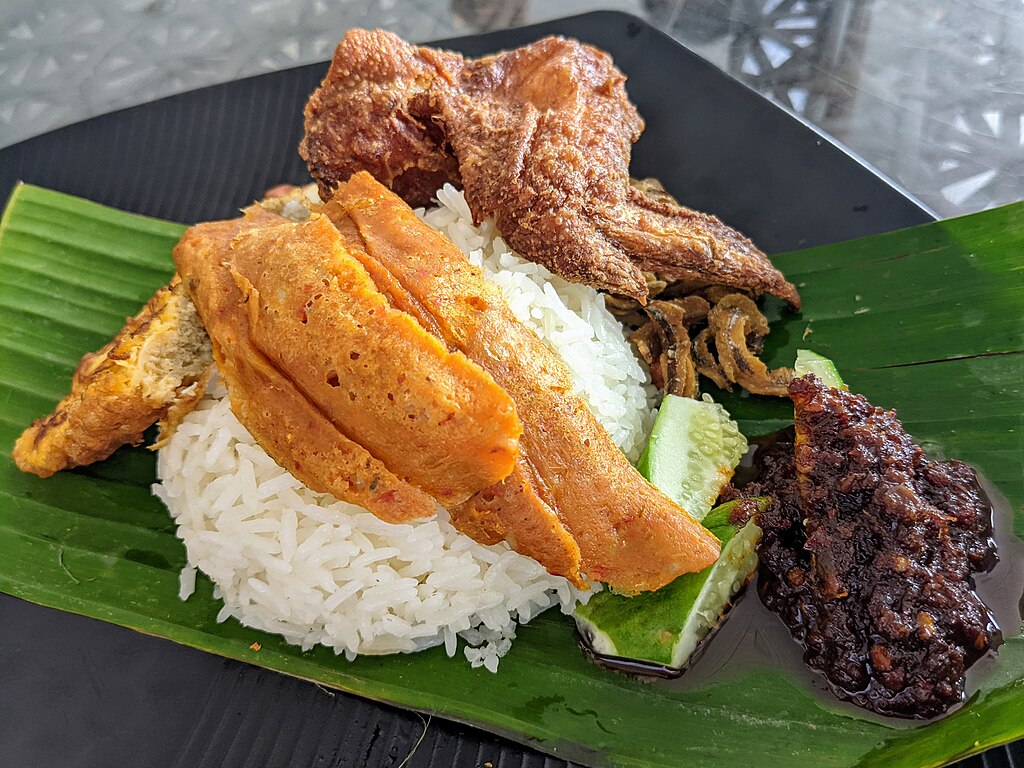Nasi Lemak: from banana leaves to white tablecloths
Born in the fields and kitchens of rural Malaysia, nasi lemak began as a humble meal. Its fragrant coconut rice and fiery sambal create a delicate balance of spice and comfort. Just a fourteen-hour flight away, you’ll find the vibrant streets of Malaysia, lush with hawker stalls nestled by the refreshing seaside or along bustling roads, where locals and tourists alike can enjoy a taste of this iconic dish.
The name “nasi lemak” comes from the Malay terms for “rice” (nasi) and “creamy-rich” (lemak), a reference to incorporating coconut milk into the rice for a nutty, buttery flavour. Its origins can be traced back to 1909, when it was first mentioned in The Circumstances of Malay Life by Sir Richard Olof Winstedt. Recognised as a Malay dish, nasi lemak was originally popularised as a breakfast food and served to farmers and laborers as a hearty start to their day. This connection to agrarian life gave the dish its initial identity as an accessible and practical meal, tightly woven into the rhythms of rural Malaysian life.
Over decades, nasi lemak became a unifying symbol, transcending ethnicity and class to become a Malaysian staple.
Historically, nasi lemak has been closely associated with Malay culture, serving as a culinary embodiment of Malaysia’s agricultural roots. The dish’s simple yet flavorful ingredients—coconut rice, sambal, anchovies, and eggs—reflect the local abundance of resources, particularly in coastal and agricultural regions. The banana leaf wrapping not only preserved the food but also showcased the eco-conscious traditions of the time. Over decades, nasi lemak became a unifying symbol, transcending ethnicity and class to become a Malaysian staple. Vendors sold it by the roadside, which is a convenience for Malaysians on the go. These stalls became an integral part of the culture. Stopping by a roadside stall to enjoy nasi lemak amidst the bustle of everyday life is an immersion into Malaysian culture.
The transformation of nasi lemak from street food to fine dining has sparked debates over authenticity and accessibility. Upscale versions often feature premium ingredients like Australian wagyu beef, lobster, or even foie gras. Take, for example, NALÉ, a restaurant in Kuala Lumpur that serves nasi lemak with Australian wagyu for RM89.90. Compare that to the RM5, which you might spend at a roadside stall for a just as delicious version—if not more so. While the quality of ingredients may differ, the dining experience often lacks the cultural intimacy of enjoying nasi lemak as intended.
It could not compare to the flavours that made nasi lemak special in its humble beginnings.
In Kota Kinabalu City, the now-closed Tavern Kitchen & Bar once served a lobster-infused nasi lemak, limited to just 30 plates daily. My family and I were fortunate to try it during a trip to Sabah. While the experience was unique, the unanimous verdict among us was clear: it was interesting to try once but never again. It could not compare to the flavours that made nasi lemak special in its humble beginnings. With its decadent but distinctive taste, lobster disrupts the balance and accessibility core of nasi lemak’s identity. It transforms a comforting, easygoing meal into something extravagant, adding pressure to savour every bite—not for the flavour, but for the hefty price tag.
In my view, they seldom seek to redefine the identity of the national dish with “upscale” ingredients and a sense of superiority; instead, they aim to spark conversation through social media with a shock factor that could be seen as a harmless money grab and marketing tactic.
Some variations of nasi lemak have embraced a more playful approach. Nasi lemak-flavored ice cream and burgers, for instance, are novel creations intended to delight and surprise. Unlike the reinventions seen in fine dining, these variations often aim to bring the dish to local audiences in a fun and relatively affordable way. In my view, they seldom seek to redefine the identity of the national dish with “upscale” ingredients and a sense of superiority; instead, they aim to spark conversation through social media with a shock factor that could be seen as a harmless money grab and marketing tactic. It does not intend to alter the national dish beyond that. However, upscale concepts threaten to rewrite the cultural identity of nasi lemak more directly by claiming to serve “the best nasi lemak in town”. The charm of nasi lemak lies in its simplicity and accessibility—its ability to be a meal for the people. Reimagining it as haute cuisine can strip it of the qualities that made it beloved.
The difference between paying more for higher-quality ingredients and unnecessary embellishments is stark.
To call nasi lemak a national dish is to take pride in its roots and cultural significance. Yet, as it enters the realm of white tablecloths and high-end dining, it risks losing the identity that makes it a Malaysian treasure. The difference between paying more for higher-quality ingredients and unnecessary embellishments is stark. While both can coexist, honouring the origins of nasi lemak and the values it represents is essential before experimenting with your taste buds to different variations.
Nasi lemak will always embody the heart of Malaysia within its coconut-scented rice and fiery sambal. It is more than just a dish; it is a symbol of unity and identity. It bridges ethnic and cultural divides in Malaysia, celebrated by Malays, Chinese, Indians, and others alike. However, do not mistake the national dish for remaining confined within the geographical boundaries of Southeast Asia. Instead, the dish follows its people. In the hidden corners of Coventry lies Warung by Evrocafe, where you could try your first taste of nasi lemak.

Comments